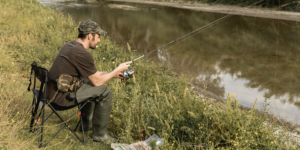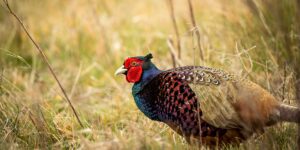Grouse hunting can cover a wide range of meanings and missions for upland hunters. From Ruffed Grouse in the thick north woods of Minnesota, Wisconsin and Michigan to Sharp-Tailed grouse in the open plains of the Dakotas, different grouse species vary greatly in their behaviors and preferred habitat but also can share many similarities.
Why limit yourself to public land when there are millions of acres of private land to explore.
Best Habitat for Grouse Hunting
Ruffed grouse, Spruce grouse and even Blue grouse can be mostly lumped into the same category in terms of the habitat that they prefer. These three birds typically live in the northern reaches of the US and into Canada. Thick, younger growth timber such as aspen or birch with a mix of pine is a great place to start especially for Ruffed and Spruce grouse. Both of these species also gravitate towards lower land areas and swamp edges at times where cover tends to be thickest. Blue grouse still prefer thick forested areas with a nod to pine trees but they are a western bird that lives in the higher elevation terrain throughout Colorado, Wyoming, Montana and other Rocky Mountain range states.
Sharp-tailed grouse are much more closely related to Pheasants and Hungarian Partridge. They prefer open plains, grasslands and farm country in most cases. Expansive grasslands with access to grains and other food sources are the ideal locations to find “Sharpies”. North Dakota, South Dakota and Montana are commonly seen as the states that offer the majority of habitat that meet the needs of Sharp-tail.
Ptarmigan reside the furthest north and in the most radical habitat of any bird in the grouse family. Northwest and northern Canada make up the bulk of the Ptarmigan region. Open tundra areas in arctic climates is their preference. They live at elevations and in climates that ultimately don’t allow the growth of trees. Tundra is the common denominator here where hopeful hunters can expect to encounter this beautiful bird.
Popular Types of Grouse to Hunt
Ruffed grouse and Sharp-tailed grouse are the most popular species in this category for upland hunters. Both can be found in great numbers in their respective regions but both offer some of the most challenging hunts. Ruffed grouse, often referred to as “The King” of upland birds live in such thick timber and flush with so much speed and agility that they can be difficult to see let alone drop with a shotgun. Even the best wingshooters typically leave a Ruffed grouse hunt scratching their heads. Sharp-tail present an entirely different challenge. They are hunted in wide open grassland where they have the ability to detect danger from great distances. They are extremely flighty and difficult to get close to. Many miles need to be put on to find sharp-tails within shotgun range.
Blue grouse and Spruce grouse aren’t as often targeted specifically by upland hunters. These two species are more commonly encountered while hunting Ruffed grouse and can offer a bonus for hunters. Populations of each of these birds aren’t as strong but can still be found within the ranges that they inhabit.
Ptarmigan fall into the bucket list hunt category, likely due to the great distance that needs to be traveled to find yourself in the areas that they live. For this reason, this is another grouse species that isn’t extremely popular. Making the trip to the upper reaches of Canada and into the tundra can create an incredible experience for hardcore upland hunters looking for a unqiue hunt.
Grouse Hunting Strategies
We’ll combine Ruffed grouse, Spruce grouse and Blue grouse into one category when discussing strategies for grouse hunters. Despite their regions differing slightly, these three birds live in the timber. Oftentimes preferring aspen, birch and differing pine tree types that create high stem count zones. All three grouse present a similar challenge in that they are difficult to flush in open enough areas for a solid visual and a realistic shot opportunity. To improve your chances, finding National or State Forest Lands that have logging roads or other forms of trail systems is a great place to start. Private land with a trail system is also a great option. Sticking to a trail not only opens up your potential shot opportunities but these birds often relate to these areas as well. A trail or road provides an edge or a change in habitat that nearly every game animal can relate to. Many National, State or even managed private lands also plant clover and other forms of food on trails as well creating another draw.
As is the case for all types of upland hunting, a great bird dog can provide a huge advantage for hunters. But again, these three grouse species still have the odds in their favor even against the best bird dogs due to the habitat they live in. There are two types of bird dogs that can find success in the grouse woods. The first is a very nosey but close working dog that lets their owner know when a bird is near with a point or a birdy demeanor all while keeping their owner close by in shotgun range. The second, is a rangier dog that can lock birds down with an extremely staunch point. These dogs can cover much more ground but need to be able to hold a bird until hunters can locate them, catch up and get themselves into range before the bird flushes.
Sharp-tailed grouse and Ptarmigan are the ideal birds for long ranging dogs like English Pointers, Setters or Shorthairs. These birds live in such expansive open ground that a good grouse dog that covers ground and can hold a point is almost a necessity. Another tip when chasing these birds is a good pair of boots and the expectation that you’re going to cover several miles if you’re expecting to get these birds in shotgun range.
When thinking about gear, hunter’s don’t need a large caliber shotgun to hunt grouse. In fact a lighter, shorter firearm is oftentimes preferred. None of the grouse species mentioned are large in size or extremely tough. A 16, 20 and even 28 gauge are usually the choice for grouse hunters. Many miles of walking and the potential for ducking and twisting through thick woods makes these guns the best option. Along these same lines, a high quality, durable and lightweight boot is a must for grouse hunters. Covering ground in comfort is number one in upland hunting.
The hassle free way to monetize your acreage.
Best States for Grouse Hunting
Ruffed and Spruce grouse are typically pursued in Maine, Michigan, Minnesota, New Hampshire and Wisconsin. Michigan, Wisconsin and Minnesota are certainly the gold standard. Nearly endless public and private land is at the fingertips of grouse hunters in these states.
Sharp-tailed grouse are traditionally hunted in North Dakota, South Dakota and Montana. Open grasslands, grains and plains are the staples when chasing sharpies.
Blue grouse, although not as popular, are hunted in Colorado, Idaho, Oregon, Washington, Nevada and parts of Utah. Many times being encountered while grouse hunters are pursuing Ruffed grouse in these same states.
Ptarmigan are exclusively going to be found north of the lower 48. Alaska and Canada will provide the most realistic opportunities to chase these tundra birds. Again, a bucket list hunt the upland hunters should consider.
See our list of the best states for Upland Bird Hunting
Where to go Grouse Hunting: Public vs Private Land
Public Land
Arguably, grouse hunting offers some of the easiest public land access opportunities in all of hunting. Especially when referring to Ruffed, Spruce, Blue and even Sharp-tailed grouse. Literally MILLIONS of acres of State and National Forest Land are available to grouse hunters in Minnesota, Wisconsin, Michigan and the western states where the bulk of Ruffed, Spruce and Blue grouse hunting takes place. Endless logging roads and walking trails are waiting for eager hunters to explore the best grouse habitat available to upland hunters.
Sharp-tailed grouse are also very accessible on public land due to some of the massive National Grassland areas in the Dakotas that offer some of the very best habitat for these game birds. Other public land programs across North Dakota, South Dakota and Montana are plentiful and can provide great access as well. Waterfowl Production Areas, Walk-In Programs and State Game areas all give hunters a great chance to find public land wild birds.
Private Land
Private land access isn’t quite as simple in regions where Ruffed grouse hunting takes place due to the vast nature of the northwoods and its properties. The same can be said for Spruce and Blue grouse. But with the right tools, private land can be an excellent option especially when hoping to avoid other hunters.
Private land comes into play a bit more when considering sharpies. Good grouse cover is often found on and around privately owned farmland in the form of grass, wheat stubble, alfalfa and other short but thick forms of cover. This puts a great value on knowing the details and having access to privately owned land that has either been granted permission to or that is enrolled in a program that allows the public to use that land for hunting and other recreational activities. Through these avenues and even leasing programs, private land can be acquired for little or no cost, which just might unlock some of the very best grouse hunting spots you’ll find.
Click on one of the map pins below to learn more about the properties.



